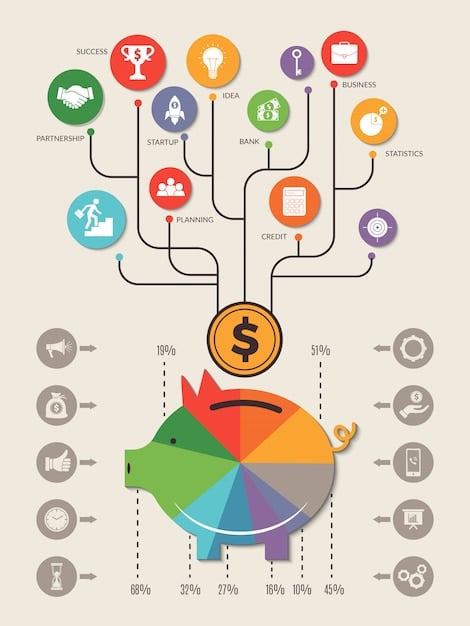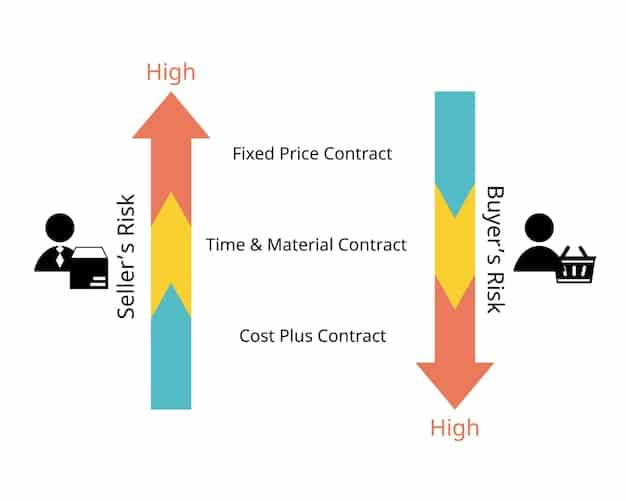Inflation Update: Navigating the 3.2% Increase for Your Business

Inflation Update: Navigating the 3.2% Increase for Your Business involves understanding the multifaceted impact on operational costs, consumer behavior, and strategic financial planning, requiring businesses to adapt pricing strategies and explore efficiency improvements.
The latest Inflation Update: How Will the Latest 3.2% Increase Affect Your Business? is a critical consideration for all business owners. Understanding the implications of inflation is essential to make sound financial decisions and stay ahead of the curve.
Understanding the Latest Inflation Figures
The recent inflation update indicates a 3.2% increase. This number, while seemingly small, can have significant ripple effects across your business. It’s crucial to understand what this percentage represents and how it’s calculated so you can accurately assess its impact.
Inflation refers to the rate at which the general level of prices for goods and services is rising, and subsequently, purchasing power is falling. The 3.2% figure represents the annualized change in the Consumer Price Index (CPI). The CPI measures the average change over time in the prices paid by urban consumers for a market basket of consumer goods and services.
Key Components of the CPI
The CPI is a weighted average of prices for various categories. Changes in these categories can significantly influence the overall inflation rate.
- Housing: This is often the largest component, including rent, mortgage costs, and utilities.
- Transportation: This includes gasoline prices, vehicle costs, and public transportation fares.
- Food: This category encompasses groceries and restaurant meals.
- Medical Care: This includes costs for doctor visits, hospital services, and prescription drugs.
By understanding these components, businesses can better anticipate how inflation will affect their specific operational costs and plan accordingly.
In conclusion, the 3.2% inflation increase signals changing economic conditions that require careful monitoring. Grasping the components of the CPI and their impact on your business will allow for more informed and strategic decision-making.
How Inflation Impacts Your Business Directly
Inflation doesn’t just exist as a number; it directly affects various aspects of your business operations. Understanding these impacts is crucial for developing strategies to mitigate potential losses.
Rising prices influence everything from raw materials to labor costs. Businesses need to recognize these effects and adjust their strategies accordingly to maintain profitability.

Increased Costs of Goods and Services
One of the most immediate effects of inflation is the rising cost of goods and services. This can impact:
- Raw Materials: Suppliers may increase prices for raw materials, driving up your production costs.
- Inventory: The cost of replenishing inventory rises, which can squeeze profit margins if you don’t adjust sales prices.
- Operational Expenses: Utility bills, transportation costs, and other operational expenses increase in tandem with inflation.
These increased costs put pressure on your bottom line, making it essential to find ways to offset these expenses.
Wage Pressures
As the cost of living increases, employees may demand higher wages to maintain their standard of living. This phenomenon is known as wage inflation. Key considerations include:
- Employee Retention: Failing to meet wage demands can lead to higher employee turnover.
- New Hires: Attracting new talent becomes more expensive as prevailing wage rates increase.
- Benefits Costs: The costs of providing healthcare and other benefits can also increase during inflationary periods.
Addressing wage pressures requires a balanced approach, considering both employee needs and business financial health.
In summary, inflation directly escalates operational costs and introduces wage pressures, directly impacting your business profitability. Strategic planning to address these challenges is essential for sustainable growth.
Adjusting Pricing Strategies in Response to Inflation
One of the most critical responses to inflation is adjusting your pricing strategies. Failing to adjust can lead to diminished profit margins, while adjusting too aggressively can alienate customers.
Companies need to strike a balance that ensures profitability while remaining competitive. Several strategies can be used to achieve this delicate equilibrium.
Cost-Plus Pricing
This involves adding a markup to your total costs to determine the selling price. Here’s how to implement it effectively:
- Calculate Total Costs: Account for all direct and indirect costs associated with producing your goods or services.
- Determine Your Desired Markup: Decide on a markup percentage that ensures profitability without pricing yourself out of the market.
- Regularly Review and Adjust: Monitor cost changes and be prepared to adjust prices as needed.
Value-Based Pricing
This approach focuses on the perceived value customers place on your products or services. Here are some key steps:
- Understand Customer Perceptions: Research what your customers value most about your offerings.
- Highlight Unique Benefits: Communicate the distinctive benefits that set you apart from competitors.
- Justify Price Increases: Provide clear reasons why prices are increasing, emphasizing the value customers receive.

Value-based pricing can provide flexibility during inflationary periods, but it requires deep customer insights.
Competitive Pricing
This involves setting prices based on what your competitors are charging. To implement this strategy:
- Monitor Competitor Prices: Regularly track the prices of your main competitors.
- Price Matching: Consider matching competitor prices to remain competitive.
- Differentiate Through Value: If you can’t match prices, emphasize unique value propositions.
In conclusion, adjusting pricing strategies is critical for navigating inflationary pressures. Selecting the right approach—whether cost-plus, value-based, or competitive—depends on your market, customer base, and unique business model.
Managing Supply Chain Disruptions
Inflation often coincides with supply chain disruptions, compounding challenges for businesses. Proactive management of these disruptions is crucial.
Supply chain disruptions can lead to increased costs, delays, and shortages. Companies need to diversify their supply chains and improve inventory management.
Diversifying Your Supply Chain
Relying on a single supplier can be risky during inflationary periods. Diversifying your supply chain helps mitigate these risks:
- Identify Alternative Suppliers: Research and vet multiple suppliers, both domestic and international.
- Establish Backup Agreements: Negotiate backup agreements with alternative suppliers.
- Geographic Diversification: Spread your supply base across different geographic regions to avoid localized disruptions.
Inventory Management
Effective inventory management can minimize the impact of supply chain disruptions:
- Increase Safety Stock: Hold additional inventory to buffer against unexpected delays or shortages.
- Just-in-Time Inventory: Adopt a just-in-time approach to minimize holding costs while ensuring timely availability of materials.
- Accurate Forecasting: Leverage data analytics to improve demand forecasting and inventory planning.
By diversifying your supply chain and optimizing inventory management, you can minimize the impact of inflationary pressures and maintain operational stability, ensuring your business remains adaptable and resilient in the face of economic challenges.
Cost-Cutting Measures to Offset Inflation
When revenues are squeezed by inflation, cost-cutting measures become essential. Identifying areas for efficiency gains can help maintain profitability without compromising quality.
Strategic cost-cutting involves a careful review of all expenses, identifying areas where savings can be achieved without undermining core operations.
Energy Efficiency
Reducing energy consumption can lead to both cost savings and environmental benefits:
- Energy Audits: Conduct comprehensive energy audits to identify areas of waste.
- Upgrade Equipment: Invest in energy-efficient equipment and lighting.
- Employee Training: Educate employees about energy-saving practices.
Negotiate with Suppliers
Re-negotiating terms with suppliers can result in significant cost reductions:
- Volume Discounts: Negotiate discounts for larger order volumes.
- Extended Payment Terms: Request longer payment terms to improve cash flow.
- Competitive Bidding: Solicit bids from multiple suppliers to ensure you’re getting the best price.
In conclusion, implementing various cost-cutting measures, from enhancing efficiency to streamlining supply chains, is essential for businesses aiming to mitigate inflation’s impact, ensuring financial stability.
Leveraging Technology to Improve Efficiency
Technology offers powerful tools for improving efficiency and productivity, offsetting the negative effects of inflation.
Investing in technology can reduce labor costs, streamline processes, and improve decision-making, providing a sustainable competitive advantage.
Automation
Automating routine tasks can free up employees to focus on more strategic activities:
- Robotic Process Automation (RPA): Use RPA to automate repetitive tasks such as data entry and invoice processing.
- Customer Relationship Management (CRM): Implement a CRM system to automate sales and marketing efforts.
- Enterprise Resource Planning (ERP): Adopt an ERP system to automate and integrate various business functions.
Data Analytics
Leveraging data analytics can provide valuable insights for improving decision-making:
- Predictive Analytics: Use predictive analytics to forecast demand and optimize inventory levels.
- Performance Monitoring: Implement dashboards to monitor key performance indicators (KPIs) and identify areas for improvement.
- Customer Insights: Analyze customer data to improve targeting and personalization.
In summary, strategically leveraging technology, including automation and data analytics, can significantly improve efficiency, reduce costs, and enable data-driven decision-making, empowering businesses to navigate inflationary pressures effectively.
Seeking Financial Advice and Support
Navigating inflationary periods can be complex, making financial advice and support invaluable.
Consulting with financial experts can provide insights and strategies tailored to your specific business needs, ensuring you make informed decisions and stay on track toward financial stability.
Professional Consultation
Engaging with financial advisors offers expert guidance and perspectives:
- Financial Planning: Consult with a financial planner to develop a comprehensive plan tailored to your business goals.
- Tax Planning: Seek advice from a tax professional to optimize your tax strategy and minimize liabilities.
- Investment Advice: Work with an investment advisor to manage your business’s investments and optimize returns.
Government Support and Incentives
Explore available government programs and incentives to help offset inflationary pressures:
- Tax Credits: Research available tax credits for investments in energy efficiency, research and development, and other areas.
- Grants and Loans: Investigate government grants and loan programs designed to support small businesses.
- Economic Development Programs: Participate in local economic development programs to access resources and support.
In conclusion, seeking professional financial advice and exploring government support programs are essential steps for businesses navigating inflationary times, ensuring informed decisions and access to vital resources for financial stability and growth.
| Key Point | Brief Description |
|---|---|
| 💰 Cost Increases | Rising prices of raw materials, inventory, and operational expenses. |
| 📈 Wage Pressures | Increased cost of living may lead to demands for higher wages. |
| ⚙️ Efficiency Measures | Implementing cost-cutting, technology, and efficiency improvements. |
| 🤝 Financial Support | Seeking professional advice and exploring government incentives. |
FAQ
▼
A 3.2% inflation rate indicates a moderate increase in the general price level of goods and services. While not an extreme level, it can still erode purchasing power and increase business costs, thus necessitating strategic adjustments.
▼
Businesses can consider cost-plus pricing, value-based pricing, or competitive pricing. Regularly monitoring costs and customer perceptions is crucial for making informed pricing decisions and maintaining profitability.
▼
Key areas for cost-cutting include energy efficiency, renegotiating with suppliers, streamlining processes, and reducing waste. Conducting thorough cost analyses can help identify opportunities for savings without undermining core operations.
▼
Technology, such as automation and data analytics, can improve efficiency, reduce labor costs, and enable better decision-making. These tools provide insights that help businesses optimize resource allocation and streamline processes.
▼
Financial support includes professional consultation with financial advisors, government tax credits, grants, and loan programs. Additionally, local economic development programs can offer resources and assistance to help businesses thrive.
Conclusion
In conclusion, navigating the challenges posed by the latest 3.2% inflation increase requires a multifaceted approach. By understanding the direct impacts of inflation, adjusting pricing strategies, managing supply chains effectively, implementing cost-cutting measures, leveraging technology, and seeking financial advice, businesses can mitigate risks and ensure long-term stability and growth.





